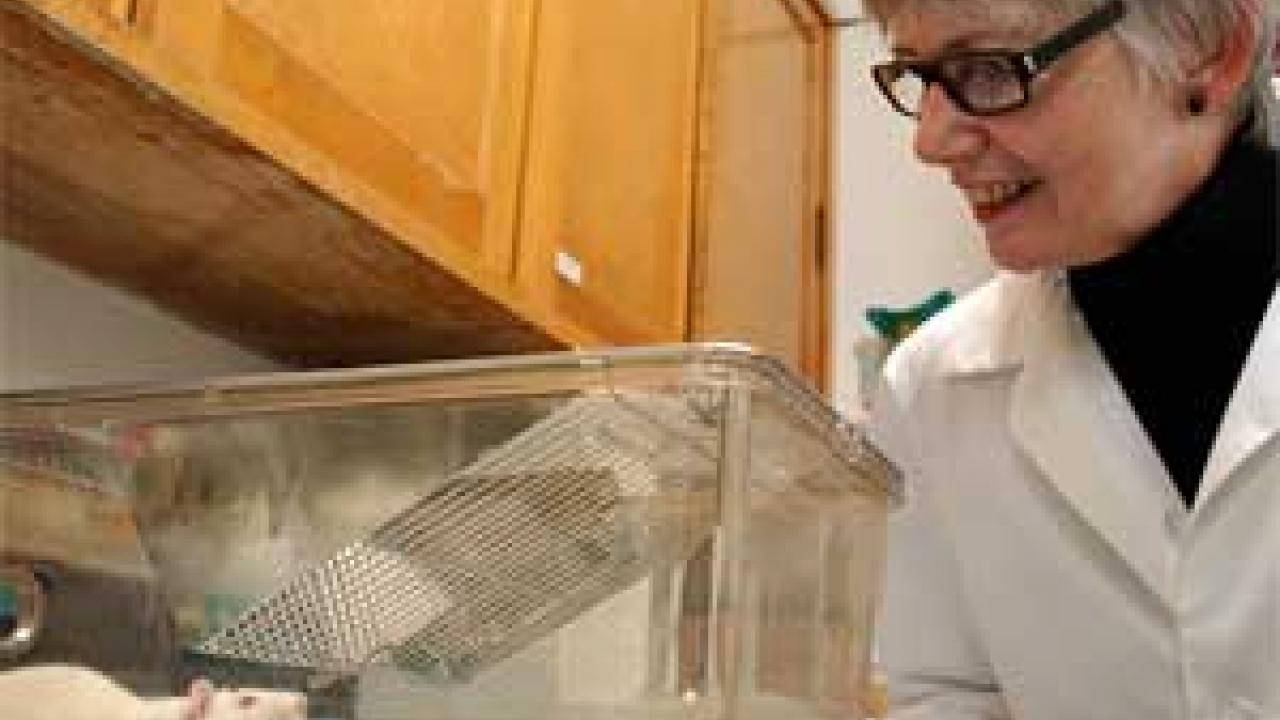The biochemical mechanism that enables animals -- likely including humans -- to recognize when their diet is deficient in an essential amino acid has been identified for the first time by researchers at the University of California, Davis.
The findings by neurophysiologist Dorothy Gietzen and colleagues at UC Davis' School of Veterinary Medicine have implications for human health, particularly epilepsy, since some forms of epilepsy are influenced by amino acid deficiencies. That is because amino acids are the chemical units that the body uses to construct proteins for growth and development.
The study will appear in the March 18 issue of the journal Science.
"This constitutes a basic, well conserved mechanism in the brain of mammals that allows them to respond to nutritional stress and seek out food that will improve their chances for survival," Gietzen said.
For more than five decades, scientists have known that animals have the ability to sense when their diet is not providing sufficient amino acids. Of the 20 amino acids found in animals, eight of them cannot be produced by or stored in the body and, therefore, must be obtained through the foods the animals eat. These eight are known as "indispensable amino acids."
Previous research has shown that animals can sense within a matter of minutes if their diet is deficient in an indispensable amino acid, making use of a subconscious sensing mechanism that does not depend on taste or smell. For example, if rats are offered more than one type of feed, and the first feed they try is deficient in an indispensable amino acid, they will soon switch to another feed that provides the necessary amino acids.
Gietzen noted that animals ranging from single-cell organisms such as yeast, to invertebrates to humans, appear to have conserved this mechanism through evolution. As a result, humans have developed cultural patterns that provide important dietary choices. For example, long before people even knew of amino acids, some cultures paired rice with beans or the soybean product tofu. These are protein-rich plant foods which, when eaten together, provide a full complement of all indispensable amino acids.
Earlier research had demonstrated that the deficiency-sensing mechanism is headquartered in an area of the brain known as the "anterior piriform cortex," which is essential for behavioral responses such as those demonstrated by rats that stop eating a meal deficient in indispensable amino acids.
Scientists also knew that living organisms have a system for using amino acids to build proteins. In this system, a molecule called transfer RNA carries the amino acids to the protein-synthesizing apparatus and may "interpret" the supply of amino acids for making proteins. When amino acids are available, the transfer RNA would be "charged" -- bound to an amino acid as well as to an important enzyme in order to start the protein-building process. When an amino acid is not present, the transfer RNA is "uncharged." Earlier research with yeast suggested that an accumulation of uncharged transfer RNA initiates a signaling pathway that interrupts general protein manufacture.
Building on those findings, Gietzen and colleagues hypothesized that if uncharged transfer RNA provided the signal for deprivation of indispensable amino acids, the RNA also could create the same signal by inhibiting the charging process. To test this, they injected rats with alcohol derivatives of amino acids to stall the charging process and then measured the animals' food intake. They found that following the injections, the rats stopped eating an amino-acid-complete feed as if it were deficient in an amino acid.
Gietzen and her colleagues also demonstrated that the effect of the injection could be reversed. After the injection-related tests were performed, they offered the rats a "corrected" diet that had high levels of the amino acid that had been targeted by the injected amino acid alcohol. They found that the corrected diet reversed the effects of the injection, and the rats resumed eating.
The researchers further determined that the uncharged transfer RNA triggers the recognition of amino acid-deficient diets by affecting two genes. The first gene, known as GCN2, in turn, activates p-elf2a, which is crucial in the initiation of protein synthesis.
In mammals, which cannot make their own essential amino acids, this signaling pathway alerts the neurons in the anterior piriform cortex area of the brain, so that the neurons can send a neurochemical signal to the animal's feeding circuitry in the brain. It is this signal that causes the rat to abandon a deficient feed and begin searching for something better.
"Results from this study define the signaling pathway that, in mammals, tells the animal to go and look for a better food," Gietzen said. "Such a well-conserved biochemical pathway underscores the basic importance in a multitude of biological systems of keeping a supply of the building blocks for proteins readily available."
Gietzen said the identification of this mechanism will likely have implications for research related to epilepsy, although that specific connection is not addressed in the Science paper. Earlier research in Gietzen's laboratory has shown that, in rats, dietary deficiencies in amino acids increase the severity of and susceptibility to seizures. Furthermore, the anterior piriform cortex is the area of the brain associated with neural "excitability" and the origin of seizures.
Co-authors on this study were Shuzhen Hao, James Sharp, Catherine Ross-Inta and John Rudell, from Gietzen's laboratory at UC Davis; Brent McDaniel, Tracy Anthony and Ronald Wek, from Indiana University School of Medicine; and Douglas Cavener and Barbara McGrath, from the University of Pittsburgh.
The study was funded by the National Institutes of Health and the U.S. Department of Agriculture.
Media Resources
Pat Bailey, Research news (emphasis: agricultural and nutritional sciences, and veterinary medicine), 530-219-9640, pjbailey@ucdavis.edu
Dorothy Gietzen, Veterinary Medicine, (530) 756-9420, dwgietzen@ucdavis.edu
